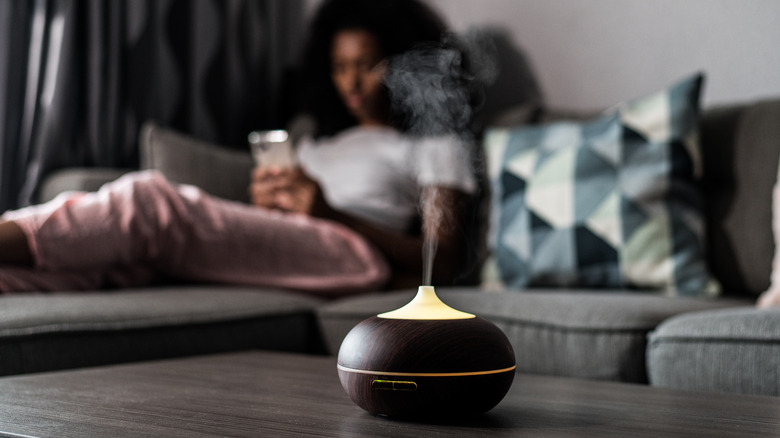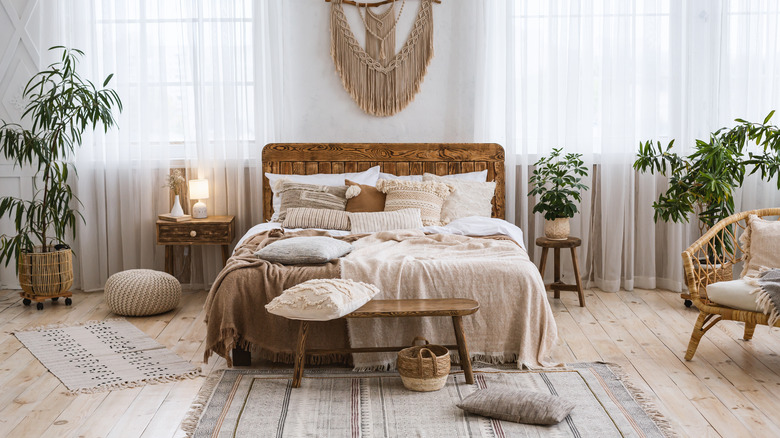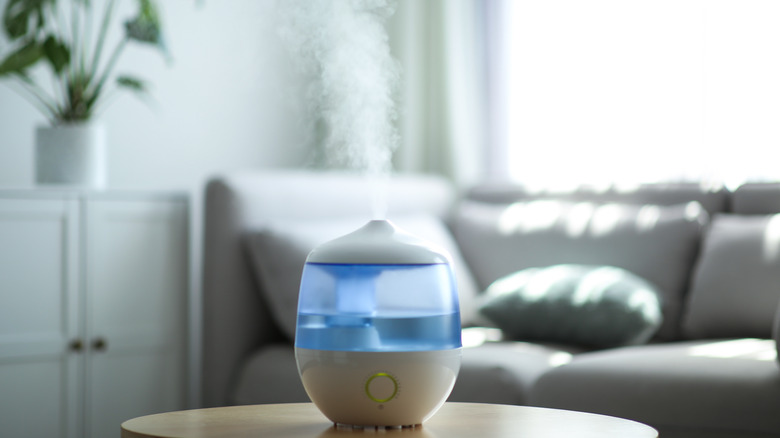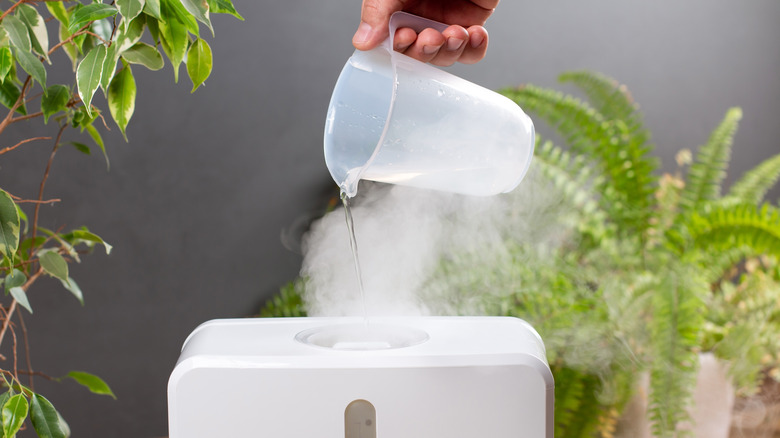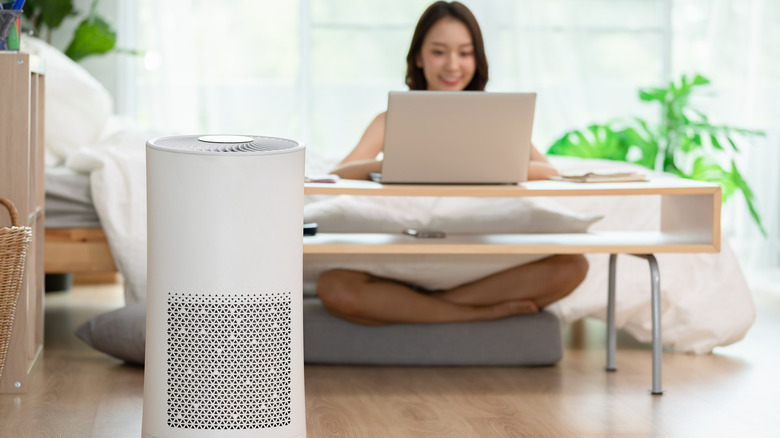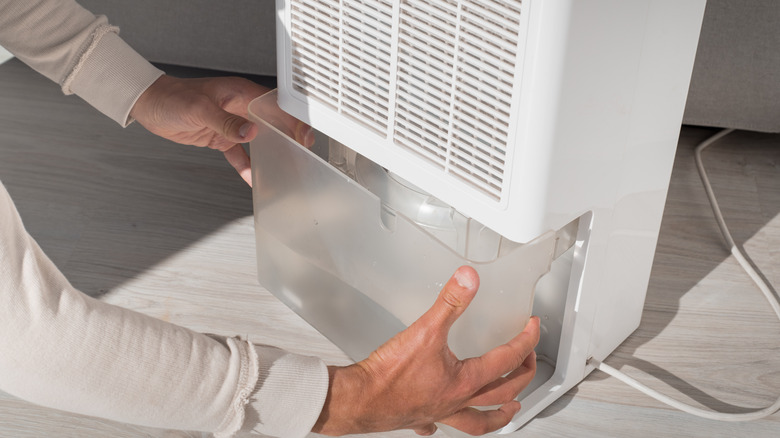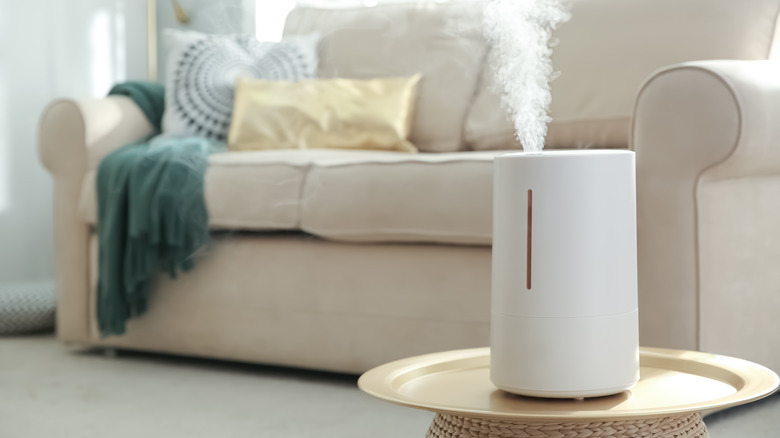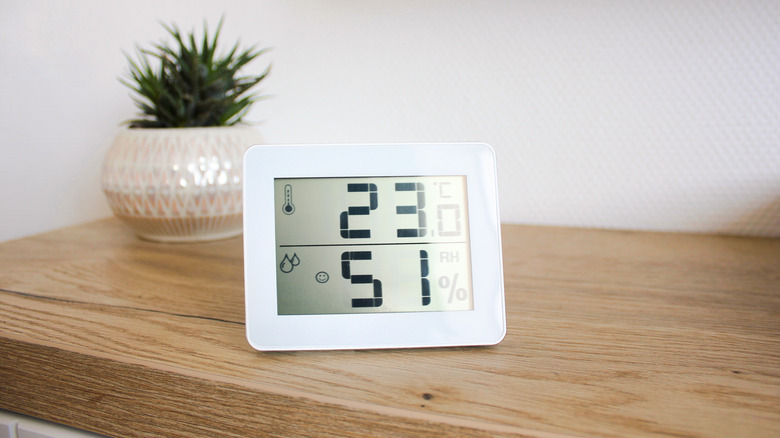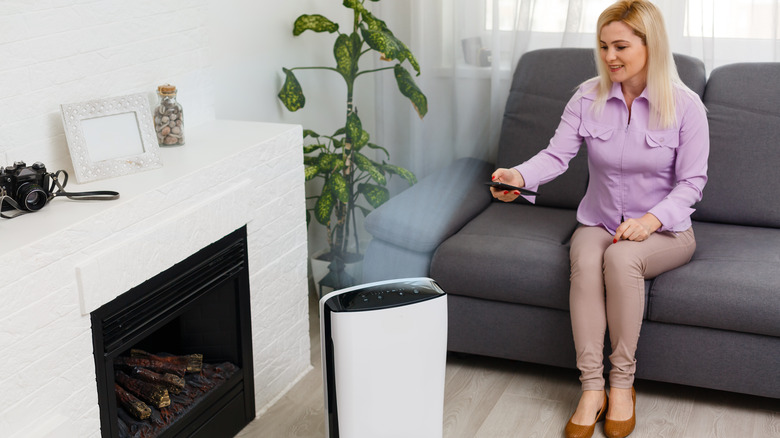10 Easy Tips For Choosing The Perfect Room Humidifier
You might notice that the air in your home can often feel quite dry, especially during the fall and winter months. Not only is it uncomfortable, but dry indoor air can lead to a whole host of issues. According to Sylvane, it can cause everything from itchy skin to cracked lips, bloody noses, irritated throats, allergy symptoms, and even flare-ups of conditions like asthma or sinus infections. Extremely dry air can also take its toll on your home and can potentially cause wallpaper to peel or windows to stick under the conditions.
Luckily, there's quite an easy fix for your dry indoor air woes — a humidifier. While you certainly could splurge on a whole-house humidifier, simply purchasing a room humidifier is often sufficient enough. If you find the right room humidifier for a space like your bedroom, you'll hopefully wake up feeling refreshed rather than dried out.
As with many small appliances or home purchases, it can be challenging to figure out exactly what you need when so many variations are on the market. For example, do you need a cool-mist humidifier or a warm mist one? Here are 10 easy tips for choosing the perfect room humidifier.
1. Figure out how much space you need to humidify
One of the first things you have to figure out when buying a humidifier is exactly how much space you're looking to fill with humid air, Sylvane explains. If you're looking to address the air in multiple rooms or even your whole house, you'll want to consider a whole-house or console humidifier.
However, if you're looking to improve the air in a space you spend a lot of time in, such as your bedroom or home office, a tabletop or room humidifier will do the job. Even within that category, though, there are differences in size. Read the humidifier's specs to see its recommended square footage. You don't want something too small, but a small bedroom doesn't need a heavy-duty humidifier, either. Generally, if you have a very large room or an open floor plan, you will want to choose a bigger humidifier that can circulate more moisture into the air.
2. Determine whether you want warm or cool mist
One of the best ways to narrow down your selection, as How to Home explains, is to decide whether you want cool mist or warm vapor being released from your humidifier. There are pros and cons to each option. Humidifiers that release warm moisture are more limited. They also use more energy and can be dangerous if pets or children touch or knock over the model. However, they're also very quiet, great in areas with soft water, and can help warm up the room, which is great for your energy bill.
Humidifiers that release cool mist are the most common humidifiers on the market, but they can potentially be noisy, depending on the model. On the plus side, though, they use minimal energy, are safe for all family members, work well in areas with hard water, and are considered better for individuals who suffer from conditions like asthma.
3. Decide which operating design you want
As The Spruce explains, there are four primary styles of room humidifiers, and each has its pros and cons. Before narrowing down which model you want to buy, you need to decide on the general style you're interested in.
Evaporative styles are inexpensive and use a fan to blow air and cool mist into the room. However, these styles are more susceptible to mold issues and need to be cleaned regularly. Impeller humidifiers feature a rotating disc that transports water onto a diffuser to be made into droplets, which are then propelled into the air. Ultrasonic humidifiers contain two ceramic plates that vibrate to produce a cool mist. Still, they may not be the best option for individuals with allergies because they move dust into the air. Last but not least, steam vaporizers are the only style that releases steam vapor rather than cool mist into the air. It's a great source of warm humidity, but these styles can be dangerous if you have pets or children.
4. Note the water reservoir capacity
You don't want a humidifier that you have to refill every single day — or worse, one that has a water reservoir so small it doesn't even last throughout the afternoon. Luckily, there is a size for every need. As The Spruce reports, there's a lot of size variation within models, from tiny cup-size humidifiers that hold just a 1/4 liter of water to room-size ones that can handle a gallon or more.
The water reservoir also has a direct impact on run time. Smaller models will need to be refilled more frequently. Consider the amount of time you'll need the humidifier on for — weighing if you want it on all day or if you're looking to run it through a whole night of sleep — and the size of the room you need to be humidified. This information will help you narrow down the exact size that will best fit your purposes.
5. Find out how loud the unit is
All humidifiers push out damp mist or steam and circulate it throughout the room, but they use different operating designs to do so. Because of this, the noise levels can potentially be disruptive in some models. This might not worry you if you're buying a humidifier for your home office where you always have your favorite tunes blasting, but you'll likely notice the noise of a particularly loud humidifier when you're lying in bed trying to sleep.
So before you spend your hard-earned money, figure out just what kind of noise level you're dealing with. If you're planning to use the humidifier in your bedroom when you're trying to sleep, Sylvane suggests considering an ultrasonic model. These humidifiers create and circulate mist through high-frequency sound waves above our hearing capacity, so they end up being much quieter than other models that use motorized fans.
6. See if it has an auto shut off feature
As with any home appliance, humidifiers run the gamut from simple models with just a few controls to more complex models with all kinds of bells and whistles. While you might not be in the market for a complex humidifier with all sorts of techy features, How to Home suggests considering whether or not you want a model with an auto shut-off feature.
While this can be great for energy savings (no one wants to keep a gadget running that's not doing anything), it can also be a great way to protect your humidifier and help it last longer. The gadget will shut off automatically when the water reservoir gets too low and needs refilling. This also means you won't have to constantly check the water levels throughout the day, hoping to switch off the machine before it runs on empty.
7. Learn what type of maintenance is required
Humidifiers help add moisture to a room and combat dry air, but humidifiers can also have a serious downside. If they are not kept clean, that moist environment inside the reservoir can become a breeding ground for all kinds of mold and bacteria, Healthline reports. And if bacteria or mold is growing inside the tank, it will eventually be pushed out through the humidifier, and into the air you breathe. So before you make any purchases, check the cleaning and maintenance requirements for your particular model and decide whether they seem too onerous to you.
In particular, you may want to examine how difficult it is to handle the water basin, as that's the primary component you'll be removing, rinsing, cleaning, and drying regularly. Depending on the type of humidifier you buy, there may also be filters or other components to keep an eye on.
8. Decide on the placement
At first glance, it may seem unimportant where you place your humidifier in your room. After all, isn't the most challenging part deciding which model to buy? While that may be true, the placement does matter. It's not as simple as finding a flat surface where the device won't tip over and spill the water inside its reservoir. Some models may need lots of space to work properly as well.
For example, Geniani warns that you never want to place your humidifier on the floor. It can cause wet floors since the mist doesn't have a chance to circulate properly with the air and instead drops down to the ground. The humidity may also damage particular textiles or even paint jobs over time, so you'll want to check that the air isn't blowing too frequently in any specific area and is instead correctly circulating throughout the entire space.
9. Keep an eye on the humidity levels
When you're dealing with super dry air in your home, it may seem like any degree of humidity is a bonus. Who doesn't want to feel like they're sleeping in a tropical environment? However, there is indeed such a thing as too much humidity. Before you crank up your humidifier to the max setting and have it running non-stop, know that humidity levels of about 50% or higher can potentially cause mold or provoke mites to reproduce, according to Self. That is certainly not what you want. They can also cause condensation and potential damage to wallpaper or paint jobs.
The sweet spot is around the 30% to 50% humidity range. This range will ensure you're fixing your dry air issue without having to combat any risks associated with higher humidity levels. Walking into a too humid room is just as troublesome as walking into an arid one.
10. Check out any other features that may be helpful
You don't necessarily need to buy a top-of-the-line humidifier with all sorts of bells and whistles to be happy with your purchase, but you may want to look at some of the available features on the market to see what you might find helpful. For example, according to Self, some humidifiers come with a humidity gauge that can help you stay in that humidity sweet spot, helping you avoid creating a too dry or too humid environment.
If you're nervous about mold and bacteria growing in the humidifier reservoir, Air Innovations suggests considering a model crafted from antimicrobial materials. Or, if you're looking for a gadget that will make your life easier, you may enjoy having a model with a remote control that will allow you to easily adjust your humidifier without having to get out of bed or off of the couch.
